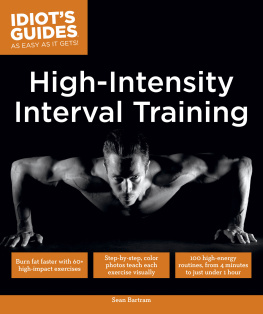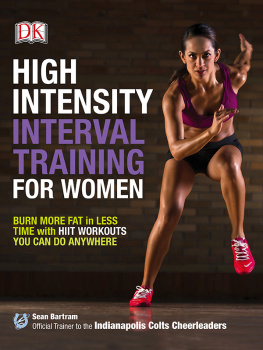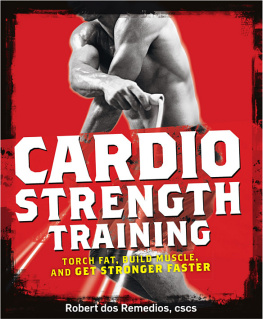The author and publisher of the information in this book are not responsible in any manner for physical harm or damages that may occur in response to following the instructions presented in this material. As with any exercise program, a doctors approval should be obtained before engaging in exercise.
Introduction
When done properly, short workouts can be highly effective. A well-planned fifteen minute workout is enough to provide the necessary stimulus to build muscle, increase strength, and burn fat. This can only be accomplished by doing a lot of work in a short amount of time. While this will not be easy, the mistake of training too hard should be avoided. In order to achieve consistent results, training intensity must be carefully controlled with an optimum level of effort. Only then can you squeeze a lot of work into a short amount time in a productive manner. The instructions in this book are designed to help you accomplish this.
Since short workouts are being recommended, you are probably wondering if there is any evidence as to whether or not brief workouts are effective. Historically, Peary Rader, Arthur Jones, Mike Mentzer, and Vince Gironda are a few notable people who favored short workouts. Of these men, Peary Rader won several weight lifting contests and was the original editor of Iron Man Magazine; Arthur Jones was the originator of Nautilus equipment and Nautilus training methods; Mike Mentzer used brief workouts to win Mr. America and Mr. Universe contests; and Vince Gironda was a top bodybuilder in the 1940s and 1050s, plus he trained many top bodybuilders including the first Mr. Olympia, Larry Scott.
Most of the men listed tended toward high intensity training. This type of training is based on pushing to do the maximum number of reps possible for each set. Normally a small number of sets are done when using high intensity training. The workouts in this book will include a modified form of high intensity training. However, much of the training methodology will resemble the style of brief workouts that Vince Gironda advocated. Girondas form of training was not only good for building muscle, but it was also good for burning fat. Vince believed in doing as many sets as possible in a short amount of time. When using his method, intensity builds from set to set and reaches a peak by the last set.
Vince gives an account of how he discovered the effectiveness of short workouts. It started when he decided to enter physique competitions. He had reached the point where he could no longer face the long tedious workouts he had been doing. Because of this, he decided to try to get his workouts over as fast as possible. After making this change, Vince said, Now for the first time, I began to show real muscularity and gains. The men who judged the contests at this time were puzzled by so much muscularity. What seemed to be a compromise when Vince decided to do shorter workouts actually turned out to work in his favor.
Vince successfully trained multitudes of people over the course of forty plus years and his methods still work today. Some of what is taught in this book will be similar to Girondas methods, but the training will be organized and adapted to fit within a time limit of fifteen minutes or less per workout.
One of the methods that Vince favored was to repeat the same exercise for six to eight sets with very short rests between sets. This is called straight set high density training. It will be used for some exercises in the 15 minute workouts in this book. Higher intensity training with heavier weights and fewer sets will also be utilized for other exercises. These two forms of training will combine to form the foundation for workouts that build muscle and burn fat. When used in conjunction with an optimum training intensity and the correct exercises, these methods will enable you to engage in brief workouts that produce exceptional results. The rest of this book will provide the details for how to accomplish this.
Chapter 1
High Intensity Training

The two basic methods that form the foundation for the 15 minute workouts include high intensity training and high density straight set training. These two methods help you to stimulate muscle growth in a short amount of time. The words, intensity, and density sound so similar that it is easy to mistake them for being the same thing, but they are not the same.
Training Intensity generally refers to putting forth maximum effort to complete a set of an exercise.
Training Density refers to doing a lot of sets in short amount of time.
Perhaps you have had the opportunity to watch a bodybuilder squeeze out as many reps possible before ending a set of an exercise. This is an example of training intensity. High training intensity is generated by putting forth a maximum effort to perform as many reps as possible within a set.
Benefit and Drawbacks of High Intensity Training
The benefit of high intensity training is that fairly heavy weights are used and it only takes a small number of sets to stimulate muscle growth and strength. While there are benefits to high intensity training, several drawbacks can result if it is the only type of training method used.
The first drawback is that constant high intensity training tends to be very taxing on your nervous system. This makes it easy to over-train when using high intensity training.
The second drawback is that only a small amount of sets can be done without overtraining. Doing a small number of sets will make it hard to burn calories and reduce fat.
Third, it generally takes at least three minutes for a muscle group to recover from a high intensity set. This fights against quick workouts as it is necessary to proceed quickly from set to set in order quickly complete a workout.
Modified High Intensity
When used correctly, high intensity training is an excellent way to build muscle and strength. However, when overused, it can easily backfire with overtraining and a slower training pace. For this reason, it will be modified by doing as many even-paced reps as possible within a set as opposed to dong as many total reps as possible. This will be explained in greater detail in chapter 5 which addresses optimum intensity training. In addition, modified high intensity will be alternated with high density training. By doing this, you will take advantage of the benefits of both training intensity and training density.
Chapter 2
High Density Training

While high intensity refers to high effort within a set, high density refers to doing several sets within a short time period. This can only be accomplished by taking very brief rest periods of fifteen to twenty seconds between sets. When done with same weight and exercise for each set, it is called high density straight sets.
One of the benefits of high density training with straight sets is that it provides a quick way to accumulate a substantial total workload for a muscle group. Total workload refers to the total amount of reps times the amount of weight lifted for each rep. For example, if you do 8 sets of 8 reps for the bench press, you are doing a total of sixty-four total reps. If all sixty-four reps were done with 100 pounds, the total workload would be 64 x 100, or 6,400 pounds.











